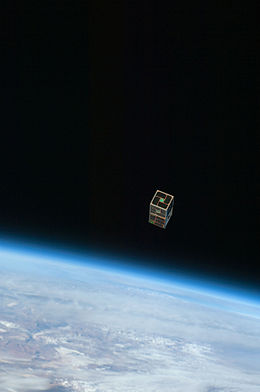 DRAGONSat as photographed after its release from Space Shuttle Endeavour's payload bay | |
| COSPAR ID | 2009-038B |
|---|---|
| SATCAT no. | 35690 |
| Start of mission | |
| Launch date | July 30, 2009 (UTC) |
| Rocket | Space Shuttle Endeavour |
| Launch site | Kennedy LC-39A |
| End of mission | |
| Disposal | Failed to separate from companion |
| Orbital parameters | |
| Reference system | geocentric |
| Regime | LEO |
| Inclination | 51.7° |
DRAGONSat (Dual RF Astrodynamic GPS Orbital Navigator Satellite) was a 2000s pair of nanosatellites that were to demonstrate autonomous rendezvous and docking (ARD) in low Earth orbit (LEO) for NASA. It was intended to gather flight data with a global positioning system (GPS) receiver strictly designed for space applications to gather flight data in the space environment. ARD is the capability of two independent spacecraft to rendezvous in orbit and dock without crew intervention. The mission failed when the DRAGONSats failed to separate from their carrier spacecraft.
One DRAGONSat was built by the University of Texas and the other one was built by Texas A and M University, the Space Shuttle Payload Launcher (SSPL), These satellite projects were planned to rendezvous and dock with each other in space without the benefit of human intervention.
DRAGONSat was planned to be an eight-year program with a launch of the satellites approximately every two years. The first three missions were to test individual components and subsystems while the final mission was to culminate with the successful docking of two satellites. Each mission was planned to build on the previous mission culminating in a fully autonomous rendezvous and docking mission. Both universities were required to use GPS receivers designed by NASA in order to determine its functionality. One of the objectives was to demonstrate precision real-time navigation capability as well as precision relative navigation between the two satellites. [1]
- ^ NASA: DRAGONSat Official Site Archived June 12, 2009, at the Wayback Machine